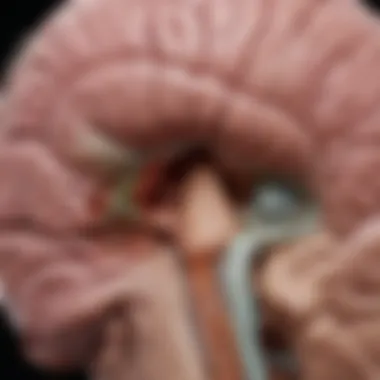Thalamic Infarct Treatment: Comprehensive Overview


Intro
Thalamic infarcts are a critical health issue impacting various aspects of neurological function. The thalamus, a vital brain structure, serves as a relay center for sensory and motor signals. Its infarction can lead to a range of deficits, such as impaired sensory perception and motor coordination.
The complexity of thalamic infarction necessitates a thorough understanding of its underlying causes and consequences. Advances in medical intervention and rehabilitation strategies are essential to improve patient outcomes. This article aims to provide an exhaustive guide on the treatment of thalamic infarcts, integrating clinical practices and current research to navigate the road towards effective recovery.
Understanding Thalamic Infarcts
Understanding thalamic infarcts is critical for effective treatment and management of this complex neurological condition. Thalamic infarcts occur when there is a disruption in blood supply to the thalamus, which is essential for relaying sensory and motor signals to the cerebral cortex. This section will explore the nature of thalamic infarcts, helping both medical professionals and patients grasp its implications. A comprehensive understanding of this condition enhances the approaches to diagnosis, treatment, and rehabilitation.
Defining Thalamic Infarction
Thalamic infarction refers to the area of tissue death due to the lack of blood flow in the thalamus. This part of the brain plays crucial roles in processing and distributing sensory information. The understanding of this condition is fundamental. It enables targeted interventions and patient education, which can effectivly influence recovery and overall quality of life. Informed medical decisions can lead to better recovery strategies, making it vital for both practitioners and patients to understand.
Pathophysiology of Infarcts
The pathophysiology of thalamic infarcts involves intricate processes that result in neuronal loss and dysfunction. When the thalamus does not receive adequate blood flow, the neurons begin to die from ischemia. This neuronal death results in various cognitive and sensory deficits depending on the specific region of the thalamus affected. Understanding these mechanisms allows for targeted therapies that can mitigate some effects or enhance recovery rehabilitation efforts.
Common Causes
Identifying the common causes of thalamic infarcts provides insights into prevention and targeted treatment. The primary reasons for these infarcts usually fall into three categories:
Ischemic Factors
Ischemic factors are a significant cause of thalamic infarction. They involve conditions that reduce blood flow to the area, often due to vascular changes. Hypertension, diabetes, and high cholesterol contribute to the narrowing of blood vessels. The key characteristic of ischemic factors is that they can often be managed through lifestyle changes or medications. Understanding these factors is beneficial because addressing them can help prevent further incidents.
Embolic Sources
Embolic sources refer to the situations where blood clots or debris travel through the bloodstream and cause blockage. This situation can lead to an acute thalamic infarct. The unique feature of embolic sources is their often sudden nature, making timely response crucial. Identifying the source of the embolism is essential for ensuring that appropriate anticoagulation therapies are initiated. Thus, analyzing the embolic sources strengthens the approach to treatment and prevention.
Other Risk Factors
Other risk factors include advanced age, smoking, and underlying health conditions such as atrial fibrillation. These factors can also predispose individuals to thalamic infarcts. A significant characteristic of other risk factors is their diversity, incorporating lifestyle and genetic components. Understanding these variable factors can inform personalized treatment plans, which might enhance recovery. This broader view on risk factors counterbalances the specific nature of ischemic and embolic causes.
Clinical Presentation
Understanding the clinical presentation of thalamic infarcts is essential for the effective diagnosis and management of this condition. Thalamic infarcts can present a range of symptoms, which often reflect the underlying neurological deficits. Identifying these symptoms improves the ability to tailor specific treatment strategies for individual patients.
Additionally, a thorough examination of signs and symptoms can help differentiate thalamic infarcts from other neurological disorders. The clinical presentation thus serves as a primary step in guiding diagnostic processes and planning subsequent therapeutic interventions.
Symptoms of Thalamic Infarcts
Sensory Disturbances
Sensory disturbances are a hallmark symptom of thalamic infarcts. Patients might experience altered sensations, such as numbness or tingling, particularly on one side of the body. This symptom often signifies damage to pathways that relay sensory information to the cerebral cortex. The unique feature of these disturbances lies in their potential to confuse both patients and clinicians alike. They might misinterpret sensory disruptions as peripheral nerve conditions or psychosomatic issues instead of a thalamic event. Recognizing these disturbances is crucial, as it can lead to more targeted investigations and, consequently, more effective personalized care
Motor Impairments
Motor impairments often accompany sensory disturbances in thalamic infarcts. These impairments may manifest as weakness, decreased coordination, or even involuntary movements. The key characteristic of motor impairments is that they may affect daily activities and overall quality of life significantly. Understanding the extent and nature of these motor deficits can inform the rehabilitation strategies that follow. It is vital to address these motor issues promptly, as they can lead to secondary complications such as musculoskeletal problems or psychosocial issues over time.
Cognitive Effects
Cognitive effects from thalamic infarcts can be broad and multifaceted. Patients may encounter challenges in attention, memory, and executive function. The impact of these cognitive changes can be profound, affecting not only the patient’s ability to perform tasks but also their overall psychological well-being. The relationship between cognitive impairments and thalamic integrity is a key area of focus in treatment discussions. Identifying these effects enables a multi-disciplinary approach to patient management, incorporating cognitive rehabilitation strategies when necessary.
Diagnostic Procedures


Imaging Techniques
Imaging techniques play a pivotal role in diagnosing thalamic infarcts. Magnetic resonance imaging (MRI) is often the preferred method, as it can reveal the precise location and extent of the infarction. The specificity of MRI allows for detailed visualization of brain structures, highlighting acute and chronic changes. However, accessibility and timing may pose challenges in some clinical scenarios, where swift intervention is vital.
Neurological Assessments
Neurological assessments provide a structured approach to understanding the functional limitations faced by a patient with thalamic infarcts. These assessments include evaluating reflexes, strength, and sensory responses, which collectively offer insights into the neurological status of the patient. A significant advantage of neurological assessments is that they can identify subtle deficits that imaging alone might miss. However, these assessments are dependent on practitioner experience and may be subjective.
Laboratory Tests
Laboratory tests aid in evaluating thalamic infarcts by ruling out underlying conditions that could contribute to infarction, such as coagulation disorders or metabolic derangements. Blood tests examining glucose, lipid profiles, and complete blood counts hold importance in the broader context of patient assessment. The challenge with laboratory tests is that they often do not provide immediate answers regarding the status of the thalamus itself, thus requiring complementary testing for a comprehensive evaluation.
Immediate Treatment Strategies
The immediate treatment strategies for thalamic infarcts are crucial for optimizing patient outcomes. Effective management during this acute phase can significantly impact recovery and reduce the risk of long-term complications. Addressing different aspects of treatment, including medical and surgical interventions, is essential to formulate a robust response to the acute neurological event. This section will cover effective acute medical management techniques and surgical interventions, illustrating how they work in conjunction to aid recovery.
Acute Medical Management
Acute medical management includes essential therapies aimed at restoring blood flow and minimizing damage to brain tissue. The strategies implemented during this phase directly affect the recovery trajectory for patients.
Thrombolytic Therapy
Thrombolytic therapy aims to dissolve blood clots that obstruct blood flow to the thalamus. This treatment is time-sensitive. Administering thrombolytics quickly can limit brain damage and improve chances for recovery. A key characteristic of thrombolytic agents, such as tPA (tissue plasminogen activator), is their capacity to restore perfusion no matter the ischemic duration. This makes it a beneficial choice in acute cases.
However, thrombolytic therapy does carry risks. The most significant risk involves hemorrhage. Patients must be carefully selected to minimize adverse reactions. Despite this, when administered appropriately, thrombolytics can provide critical benefits in managing an acute thalamic infarct.
Anticoagulation Strategies
Anticoagulation strategies involve the use of medications to prevent further clot formation and promote cerebral blood flow. Warfarin and direct oral anticoagulants are widely used to manage patients with certain risk profiles, especially those with atrial fibrillation. The main characteristic of these strategies is their ability to prevent secondary strokes and cardiovascular complications, making them vital in long-term therapy post-infarct.
Despite their benefits, anticoagulants also present challenges, such as bleeding complications and the need for regular monitoring. Patient education and proper follow-up play essential roles in the effectiveness of anticoagulation strategies.
Supportive Care
Supportive care encompasses various interventions designed to maintain physiological stability while treating the underlying infarct. This may include hydration, nutritional support, and monitoring of vital signs. The uniqueness of supportive care lies in its holistic approach to patient management, addressing not just the neurological damage but also the patient’s overall health during recovery.
The advantage of effective supportive care is its capacity to provide comfort and improve the quality of life for patients during rehabilitation. This aspect is pivotal in a comprehensive treatment plan as it helps facilitate other medical interventions.
Surgical Interventions
Surgical interventions may be required in cases where medical therapy alone is insufficient. They are crucial for catastrophic or extensive infarcts affecting the thalamus, where conventional treatments do not suffice.
Endovascular Procedures
Endovascular procedures involve less invasive techniques to manage vascular lesions or blockages. These procedures often utilize catheters to access blood vessels, allowing for targeted treatment. A significant characteristic of these techniques is their minimal invasiveness, resulting in reduced recovery time and fewer complications compared to open surgery. Endovascular procedures help restore cerebral blood flow in a controlled environment and minimize damage to surrounding brain tissue.
However, these procedures have their limitations. They may not be suitable for all types of infarcts. Additionally, operator experience and the availability of technology can influence outcomes.
Neurosurgical Options
Neurosurgical options include more invasive techniques, such as craniotomy, for direct intervention in evolving or extensive thalamic infarcts. This choice allows clinicians to directly address structural issues. A key characteristic of neurosurgical options is their ability to remove hematomas or relieve pressure from the brain, offering immediate benefits to patient stability.
However, surgery carries higher risks, including infection and neurological deficits. Therefore, it is essential to weigh the potential benefits against the inherent risks when considering surgical interventions.
The immediate treatment phase is critical. It shapes not only the present condition of the patient but also sets the stage for future rehabilitation efforts.


In summary, both medical and surgical strategies for immediate treatment of thalamic infarcts are vital components in mitigating the negative outcomes associated with this condition. Understanding and implementing these strategies effectively can lead to improved patient recovery and quality of life.
Long-Term Management Approaches
Long-term management of thalamic infarcts is crucial for optimizing recovery and facilitating the best possible outcomes for affected individuals. Unlike immediate treatment strategies, which focus on the acute phase of care, long-term management emphasizes ongoing rehabilitation and medication management. These strategies aim not only to address the direct effects of the infarct but also to improve overall quality of life. Implementing effective long-term management can prevent complications, reduce the risk of recurrence, and allow individuals to regain as much functionality as possible.
Rehabilitation Services
Physical Therapy
Physical therapy plays an integral role in the rehabilitation process after a thalamic infarct. This form of therapy focuses on restoring movement and improving physical function. It is particularly effective in addressing motor impairments that often arise from brain injuries. One key characteristic of physical therapy is that it tailor approach to each individual’s needs. This customization helps in building strength, enhancing coordination, and improving balance.
The unique feature of physical therapy lies in its ability to adapt exercises to the patient's specific limitations and progress. While beneficial for restoring mobility, its advantage also includes fostering independence. However, some disadvantages might include the need for consistent motivation from the patient, as progress can be slow and requires effort.
Occupational Therapy
Occupational therapy is equally important in the long-term management of thalamic infarcts. This therapy focuses on helping patients lead an independent life and engage in everyday activities. The key characteristic of occupational therapy is its holistic approach, which considers both physical and cognitive rehabilitation. This aspect significantly contributes to improving activities like eating, dressing, and using tools or devices.
Occupational therapy’s unique feature is its emphasis on daily tasks and the environment. By modifying tasks and environments, practitioners enhance patients' abilities in real-life situations. A drawback could be that some patients may initially resist participating in these activities, which are essential for recovery.
Speech Therapy
Speech therapy is critical for patients who experience communication difficulties or swallowing problems after a thalamic infarct. This therapy targets language, speech, and cognitive-communication issues. The key characteristic of speech therapy is its focused approach towards rebuilding communication skills. This is important for enhancing social interaction and overall quality of life.
The unique feature of speech therapy is that it often integrates both verbal exercises and non-verbal communication strategies to support patient needs. The advantages show in effective communication improvement, though some patients might find the process tedious or discouraging, especially if progress takes time.
Medication Management
Antidepressants
Antidepressants can play a significant role in managing the psychological impact of a thalamic infarct. Patients often face depression and anxiety due to changes in function and lifestyle. The key characteristic of antidepressants is their ability to balance mood and emotional well-being. These medications can be beneficial in providing relief from the emotional burden following an infarct. Notably, their unique feature includes a range of options, tailored to individual patient needs. However, some disadvantages may include delay in effect and potential side effects that could deter consistent usage.
Anticonvulsants
Anticonvulsants are essential for patients who experience seizures as a result of thalamic infarcts. These medications prevent seizure development and maintain neurological stability. The key characteristic of this class of medication is their fast-acting nature, as they often show effects relatively quickly. Anticonvulsants have the unique feature of also providing some patients with mood stabilization. Nevertheless, potential side effects can pose challenges, such as dizziness or fatigue. Careful monitoring is essential to ensure that benefits outweigh disadvantages.
Symptomatic Treatments
Symptomatic treatments refer to various medications that address specific symptoms resulting from a thalamic infarct. These treatments can target a broad spectrum of issues, including pain, spasticity, and mood regulation. The key characteristic is their targeted approach to alleviate symptoms. The unique feature of symptomatic treatments is the versatility they provide in managing diverse symptoms. While they offer significant advantages in improving comfort and function, a challenge may arise from over-reliance on medications rather than engaging in rehabilitation therapies.
Emerging Treatment Modalities
Emerging treatment modalities represent a significant aspect of thalamic infarct management. As medical science advances, new approaches and innovative therapies are being developed to enhance recovery and improve patient outcomes. With thalamic infarcts being complex conditions, these new methods provide hope for better rehabilitation and management of symptoms. Focusing on cutting-edge research, such modalities can potentially address limitations present in traditional treatments.
Innovative Therapies
Stem Cell Treatments
Stem cell treatments are increasingly recognized for their potential in neurological rehabilitation. One key aspect of stem cell therapies is their ability to differentiate into various types of cells, including neurons, which can potentially repair damaged tissue in the thalamus. This regenerative capacity makes stem cell treatments a valuable option for patients recovering from thalamic infarcts. The unique feature of these treatments is their minimally invasive nature, often requiring outpatient procedures that do not involve major surgery.
The advantages of stem cell treatments include the possibilities of neuronal regeneration and Functional recovery that may be achieved in previously affected areas. However, they also have disadvantages, such as the need for extensive research to fully understand their long-term effects. Clinical trials are essential to clarify the proper applications of stem cell technology in thalamic infarct cases.
Neurostimulation Techniques
Neurostimulation techniques are another innovative approach gaining traction in the treatment of thalamic infarcts. This method involves the use of electrical impulses to modulate neural activity, which can ameliorate various symptoms associated with the infarct. One major characteristic of neurostimulation techniques is their capability to provide immediate relief from chronic pain or movement issues. This makes them an appealing choice for managing complications related to thalamic injury.
A unique feature of these methods is their adjustability; practitioners can fine-tune stimulation parameters based on individual patient needs. The advantages include reduced reliance on pharmacological interventions, which can have side effects. However, limitations exist, such as the need for continual monitoring and adjustments, which may not be feasible for all patients.
Current Clinical Trials
Current clinical trials are crucial for evaluating new treatments for thalamic infarcts. These trials focus on assessing the efficacy and safety of innovative treatment modalities. They help determine how well new therapies work in patient populations while also ensuring that emerging treatment options adhere to medical standards. Engaging in these clinical trials benefits participants, as they receive access to novel therapies that can enhance their recovery process.


By keeping abreast of ongoing research, healthcare professionals can offer informed recommendations and integrate the best available evidence into clinical practice. Studying these trials will also help identify which subsets of patients may benefit the most from specific therapies, thus increasing the overall quality of care.
Challenges in Treatment
The treatment of thalamic infarcts presents numerous challenges that significantly impact patient outcomes. These challenges encompass both systemic barriers to receiving appropriate care and patient-specific variables that affect the effectiveness of treatment interventions. A thorough understanding of these challenges is crucial for developing comprehensive strategies aimed at improving the management of thalamic infarcts.
Barriers to Care
Access to Services
Access to services is a fundamental aspect that influences the overall management of thalamic infarcts. This refers to the availability of medical facilities, specialized practitioners, and rehabilitation resources. Areas with a limited number of healthcare providers often experience delays in diagnosis and treatment, which can worsen the patient's condition. Navigating through the healthcare system can be complex, particularly for individuals without prior experience. This complexity can deter patients from seeking timely medical help, ultimately impacting recovery outcomes.
One key characteristic of access to services is geographical location. In rural or less developed regions, patients may need to travel significant distances to access specialized care, which can be physically and financially burdensome. While telemedicine is emerging as a solution, it may not adequately substitute in-person consultations for all aspects of care.
A unique feature of access-related issues is the disparities seen across different demographics. Individuals from lower socioeconomic backgrounds may face additional challenges due to a lack of transportation or financial means. Addressing these barriers could lead to improved equity in health outcomes for thalamic infarct patients.
Financial Constraints
Financial constraints represent a significant challenge in accessing treatment for thalamic infarcts. The costs associated with acute medical interventions, rehabilitation, and ongoing management can place considerable strain on patients and their families. High expense can lead to delays in treatment or even refusal of necessary care, which often results in worsened health outcomes.
The insurance coverage landscape is another crucial element in this discussion. Patients with inadequate insurance plans may not be able to cover the costs of specialized treatment, which exacerbates the financial burden. Even among those with insurance, high co-pays or uncovered services can lead to difficult financial decisions.
A unique feature of financial constraints includes their impact on mental health. Patients facing financial difficulties often experience heightened stress and anxiety, which can complicate their overall treatment journey. Finding ways to alleviate these financial pressures is essential in ensuring that thalamic infarct patients receive timely and appropriate care.
Patient Variability
Individual Response to Treatment
Individual response to treatment is another significant aspect of managing thalamic infarcts. Each person may have a unique reaction to medical interventions based on their overall health, biological factors, and personal preferences. This variability can make it challenging for healthcare providers to predict outcomes and tailor interventions effectively.
A notable characteristic of individual response is the influence of comorbidities. Patients with existing health conditions may respond differently to standard treatments, complicating their recovery process. This variability necessitates a patient-centered approach that accounts for each individual's specific circumstances and health history.
Addressing individual treatment responses allows physicians to implement more personalized strategies. However, it can also lead to dilemmas when standardized treatment protocols clash with individual needs. Striking a balance between standardization and customization is vital for optimizing care.
Cognitive and Emotional Factors
Cognitive and emotional factors significantly influence recovery from thalamic infarcts. Mental health conditions such as depression and anxiety can complicate rehabilitation, making it critical to assess these factors as part of a comprehensive treatment plan. Patients' cognitive abilities can also impact their understanding of treatment strategies and adherence to rehabilitation protocols.
One key characteristic of cognitive and emotional factors is the interplay between physical recovery and mental well-being. Patients who are emotionally supported and actively engaged in their treatment plan often report better recovery outcomes. This relationship emphasizes the importance of a holistic approach that integrates mental health support with traditional medical interventions.
Unique features of cognitive and emotional considerations include their ability to vary widely among individuals. For some, emotional support can boost motivation and adherence; for others, psychological barriers may impede progress. Understanding these nuances is essential to developing tailored treatment plans that enhance both cognitive function and emotional resilience as patients navigate their recovery journey.
In summary, addressing the challenges in treating thalamic infarcts requires a multifaceted approach that accounts for barriers to care and individual patient differences. By acknowledging these complexities, healthcare providers can develop more effective treatment strategies and enhance patient outcomes.
Culmination and Future Directions
In summary, the treatment of thalamic infarcts represents a complex interplay of immediate interventions and long-term management strategies. As the findings of this article indicate, understanding the multifactorial nature of thalamic infarcts is essential for effective treatment. The integration of medical technologies and rehabilitative practices fosters better recovery outcomes. Clinicians must remain vigilant in tailoring individualized treatment plans, given the heterogeneous presentations and responses to therapy seen in patients.
Moreover, ongoing research is critical in uncovering new avenues for treatment. The analysis conducted throughout this article highlights notable points, such as the efficacy of various rehabilitation services and the necessity of coordinated care. Evaluating the patient's journey from acute care to rehabilitation can illuminate the complexities involved and serve to enhance interventions.
Summary of Findings
Key findings from this exploration include:
- Diversity of Symptoms: Patients often present with varied symptoms, necessitating a thorough assessment to tailor treatment.
- Importance of Immediate Care: Rapid response in acute situations can greatly impact patient outcomes.
- Rehabilitation's Role: Continued support through rehabilitation enhances recovery, addressing physical, cognitive, and emotional aspects.
- Barriers in Treatment: Identifying institutional and individual barriers to care remains crucial for developing comprehensive strategies.
These findings underscore the need for a well-rounded approach that encompasses both medical and rehabilitative interventions to optimize recovery from thalamic infarcts.
Future Research Opportunities
The treatment landscape for thalamic infarcts is continuously evolving. Future research opportunities are vital to advance our understanding and treatment methodologies. Some promising areas include:
- Innovative Therapies: More studies on stem cell treatments and neurostimulation techniques could pave the way for breakthroughs in recovery.
- Patient-Centric Studies: Research that focuses on individual differences in treatment response can lead to personalized care strategies.
- Longitudinal Evaluations: Conducting long-term studies on the effects of different rehabilitation methods will help ascertain their effectiveness over time.
- Barriers to Care Research: Investigating the socioeconomic and systemic challenges that affect access to treatment can inform policy-making and enhance service delivery.







